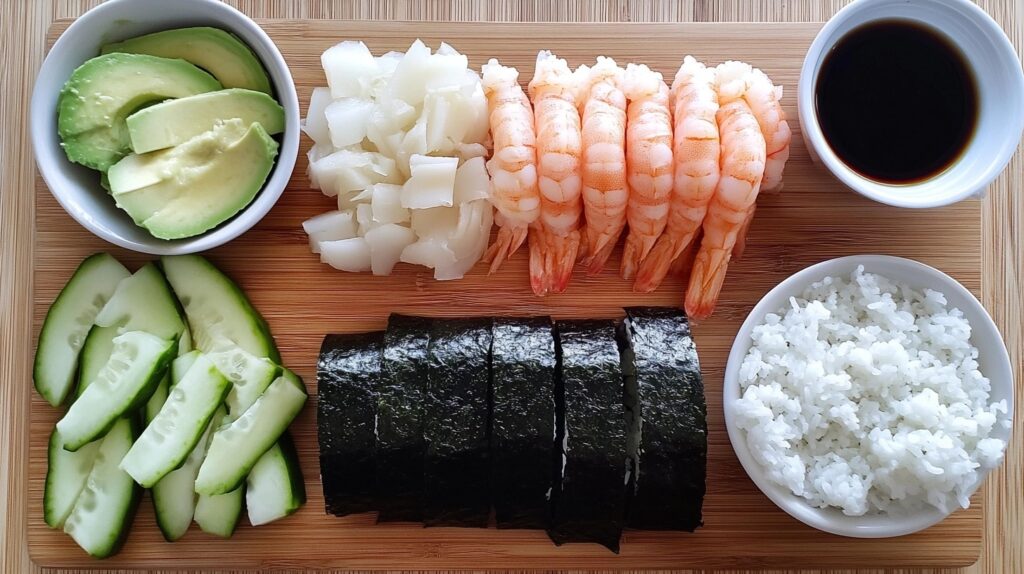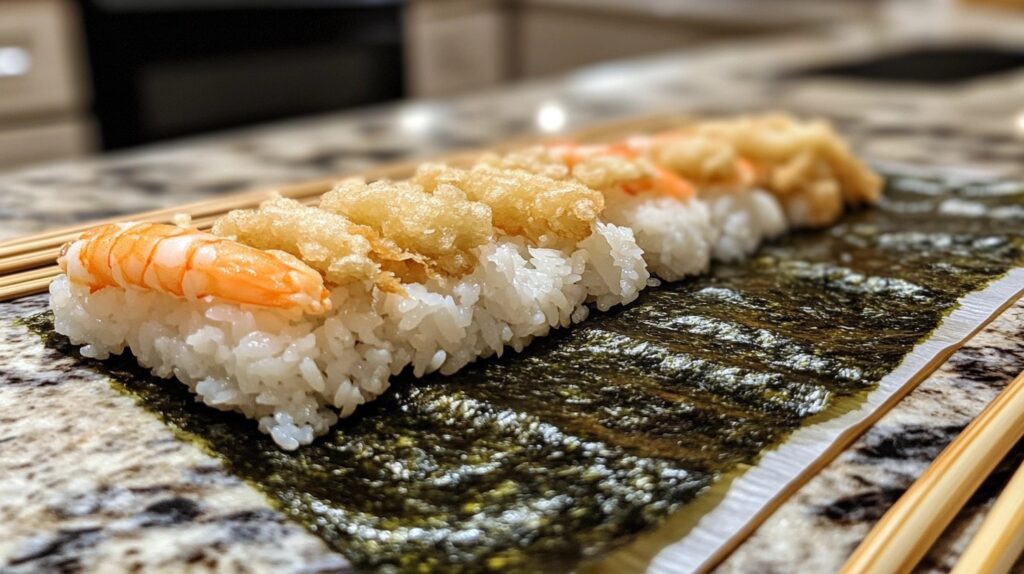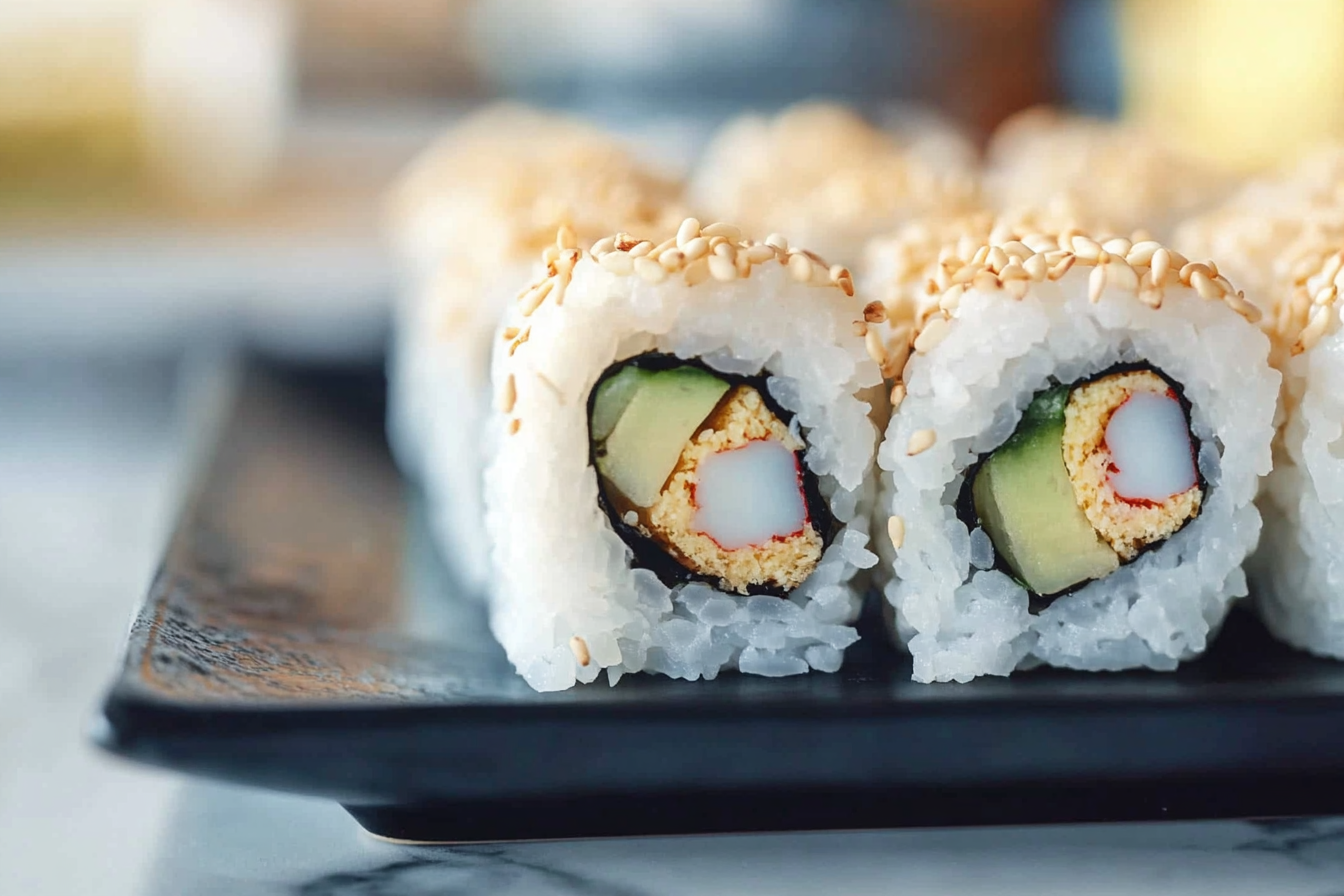What does a tempura roll have in it? Tempura rolls are an irresistible fusion of Japanese culinary tradition and creative modern sushi trends. These rolls combine the delicate flavors of sushi rice, the crispiness of tempura, and a variety of fillings that cater to diverse tastes. Whether you’re a sushi enthusiast or a home chef looking to perfect your skills, this article dives deep into what makes a tempura roll so special. From its ingredients and preparation to its nutritional profile and variations, you’ll gain all the knowledge you need to enjoy or recreate this iconic dish.
Understanding Tempura Rolls
What is a Tempura Roll?
A tempura roll is a type of sushi roll that includes deep-fried tempura as its star ingredient, wrapped with nori and sushi rice. Originating from Japan, it represents a delicious mix of crispy and soft textures, along with a blend of savory and slightly sweet flavors. Unlike traditional sushi, which often features raw fish, tempura rolls provide a crunchy twist by incorporating fried fillings such as shrimp or vegetables.
Anatomy of a Tempura Roll
Each tempura roll is a culinary masterpiece consisting of carefully chosen ingredients that complement each other perfectly. Here’s what you’ll typically find in its structure:
- Rice: Short-grain sushi rice seasoned with rice vinegar for a sticky and flavorful base.
- Nori (seaweed): A thin sheet of dried seaweed that holds the roll together.
- Tempura: Deep-fried shrimp, fish, or vegetables coated in a light, crispy batter.
- Fillings: Popular options include avocado, cucumber, imitation crab, and more.
- Toppings and Sauces: Garnishes like sesame seeds, spicy mayo, or eel sauce add a finishing touch.
Common Types of Tempura Rolls
While shrimp tempura rolls are among the most popular, there are numerous variations to try:
- Shrimp Tempura Roll: Made with crispy shrimp, creamy avocado, and cucumber.
- Vegetable Tempura Roll: Perfect for vegetarians, featuring tempura-fried vegetables like sweet potatoes and asparagus.
- Specialty Rolls: Fusion options that combine tempura with other unique ingredients, such as spicy tuna or cream cheese.
Main Ingredients in a Tempura Roll

Core Ingredients of a Tempura Roll
Rice
Sushi rice, also known as shari, is the backbone of any sushi roll. This short-grain rice is specially prepared to achieve the perfect balance of flavor and stickiness, making it ideal for rolling. To prepare authentic sushi rice:
- Wash the rice thoroughly to remove excess starch.
- Cook it using a rice cooker or stovetop, maintaining a 1:1.25 rice-to-water ratio.
- Once cooked, season the rice with a mix of rice vinegar, sugar, and salt while it’s warm.
Nori (Seaweed)
The use of nori is essential for rolling sushi. It’s a thin, slightly salty sheet of dried seaweed that holds everything together. Not only does it add structure, but its earthy flavor also complements the tempura and other ingredients.
Tempura
Tempura is the ingredient that sets this roll apart from other sushi types. The light, crispy batter is achieved by combining:
- Ingredients for Tempura Batter:
- All-purpose flour
- Ice-cold water
- Egg
- Popular Tempura Options: Shrimp, crab, sweet potato, zucchini, or mushrooms.
The batter is mixed lightly (lumps are okay), and the chosen ingredient is fried until golden. The result? A perfectly crisp exterior that contrasts beautifully with the tender fillings inside the roll.
Additional Fillings and Variations
Protein Options
While shrimp tempura is the classic choice, other proteins can be used to make your roll unique:
- Imitation crab (common in California rolls).
- Cooked fish like salmon or eel.
- Vegan-friendly options such as tofu.
Vegetable Fillings
Vegetables play a crucial role in balancing flavors and adding freshness to a tempura roll. Here are some popular choices:
- Cucumber: Provides a refreshing crunch.
- Avocado: Adds a creamy texture.
- Asparagus and Sweet Potato: When tempura-fried, they add a sweet, nutty element.
Toppings and Sauces
What’s a sushi roll without some delicious finishing touches? Garnishes and sauces elevate the flavor profile of your tempura roll:
- Toppings: Sesame seeds, masago (fish roe).
- Sauces: Eel sauce for sweetness, spicy mayo for a kick, or soy sauce for dipping.
How Tempura Rolls Are Made
The Step-by-Step Process
Making a tempura roll is an art that combines precision, patience, and a touch of creativity. Follow this step-by-step guide to craft perfect rolls at home:
Preparing the Tempura
- Choose Your Ingredients: Select shrimp, vegetables, or tofu as your tempura base. Ensure they’re clean, dry, and cut into manageable pieces.
- Mix the Batter: Combine all-purpose flour, ice-cold water, and an egg. Gently whisk the mixture to maintain a lumpy consistency. The cold temperature ensures a crispy fry.
- Fry Until Golden: Heat oil to 180°C (350°F). Dip your chosen ingredient into the batter, then fry until crispy and golden. Drain on paper towels to remove excess oil.
Rolling the Tempura Roll

- Set Up Your Workspace: Place a bamboo sushi mat on a flat surface. Cover it with plastic wrap for easy cleanup.
- Prepare the Nori: Lay a sheet of nori (shiny side down) on the bamboo mat.
- Spread the Rice: Wet your fingers to prevent sticking, then evenly spread a layer of seasoned sushi rice over the nori.
- Add Fillings: Place your tempura (shrimp, vegetables, or other choices) along the center of the rice. Add complementary ingredients like cucumber, avocado, or imitation crab.
- Roll It Up: Using the bamboo mat, carefully roll the nori from the bottom edge, applying gentle but firm pressure. Shape it into a tight cylinder.
- Cut and Serve: Slice the roll into equal pieces using a sharp, wet knife. Garnish with sesame seeds or sauce before serving.
Tips for Making Tempura Rolls at Home
- Essential Equipment: A bamboo sushi mat, sharp knife, and a rice paddle are must-haves for smooth sushi-making.
- Keep It Fresh: Always use fresh ingredients for the best taste.
- Practice Makes Perfect: Don’t worry if your first roll isn’t restaurant-quality! Rolling sushi takes time to master.
- Troubleshooting:
- If your roll falls apart, ensure the rice is evenly spread, and the roll is tightly wrapped.
- Too greasy? Ensure the oil is at the right temperature before frying the tempura.
Nutritional Information
Nutritional Content (Per 100g)
| Component | Amount |
|---|---|
| Calories | 210 kcal |
| Protein | 8g |
| Carbohydrates | 28g |
| Fats | 7g |
| Sodium | 320mg |
Popular Variations and Global Influences
Regional Variations
Although the tempura roll originates from Japanese cuisine, it has been embraced and adapted globally. Each region adds its unique twist, making tempura rolls a versatile sushi option:
- Japanese Classic: Traditional tempura rolls in Japan often feature shrimp or vegetables with minimal toppings, focusing on simplicity and balance.
- Americanized Rolls: In the U.S., tempura rolls are often larger, featuring elaborate fillings like spicy tuna or cream cheese. They’re also topped with sauces like eel sauce or spicy mayo.
- Asian Fusion: Some Asian countries add their local ingredients, like kimchi in Korea or mango in Thailand, creating bold new flavors.
Fusion Creations
The popularity of fusion cuisine has led to some exciting variations of tempura rolls:
- Philadelphia Tempura Roll: This variation combines the crunch of tempura with creamy Philadelphia cheese and smoked salmon for a rich, tangy flavor.
- Vegan Tempura Rolls: With growing demand for plant-based options, vegan rolls feature tempura-fried vegetables like zucchini, sweet potato, or even jackfruit, paired with avocado and cucumber.
- Dragon Roll with Tempura: A stunning visual delight, the dragon roll uses tempura shrimp as its base, topped with sliced avocado arranged like dragon scales.
These creative adaptations showcase how tempura rolls can cater to a wide range of palates while retaining their crispy charm.
Nutritional Information and Considerations
Nutritional Breakdown of a Tempura Roll
While tempura rolls are undeniably delicious, they can vary significantly in nutritional content depending on their ingredients and preparation. Here’s a general breakdown of a standard shrimp tempura roll:
| Component | Amount (Per Roll) |
|---|---|
| Calories | 350-400 kcal |
| Protein | 15-18g |
| Carbohydrates | 40-45g |
| Fats | 10-12g |
| Sodium | 500-600mg |
Healthier Alternatives
To enjoy tempura rolls without overindulging, consider these healthier substitutions:
- Use Air Fryers: For a lighter, crispy tempura, skip deep-frying and use an air fryer. This method significantly reduces the oil content while retaining crunch.
- Swap Ingredients: Replace white rice with cauliflower rice or brown rice for a low-carb, fiber-rich option.
- Skip the Heavy Sauces: While delicious, sauces like eel sauce and spicy mayo can add unnecessary calories. Opt for light soy sauce or lemon juice instead.
- Go Veggie-Heavy: Prioritize vegetables like cucumber, asparagus, and avocado to create a filling yet nutritious roll.
These small tweaks can make a big difference without sacrificing flavor.
Tips for Balanced Sushi Consumption
- Pair your sushi meal with miso soup or a light salad for added nutrition.
- Avoid eating too many rolls in one sitting; moderation is key.
- Opt for tempura rolls as a treat rather than a regular meal to maintain a healthy balance.
Frequently Asked Questions
What is the difference between a tempura roll and regular sushi?
While regular sushi often contains raw fish or other fresh ingredients, tempura rolls feature crispy, deep-fried tempura fillings like shrimp or vegetables. This frying process creates a crunchy texture that sets tempura rolls apart from traditional sushi, which typically emphasizes fresh, raw flavors.
Can tempura rolls be made gluten-free?
Yes, with a few adjustments! Regular tempura batter often contains wheat flour, but you can substitute it with gluten-free flour or a mix of rice flour and cornstarch. Additionally, ensure that the soy sauce or dipping sauces used are labeled gluten-free, as traditional soy sauce may contain wheat.
What are some common allergens in tempura rolls?
The most common allergens in tempura rolls include:
- Shellfish: If shrimp or crab is used.
- Gluten: Found in tempura batter and soy sauce.
- Eggs: Used in the tempura batter.
To avoid these allergens, request vegetarian or customized rolls at sushi restaurants, or make your own at home with safe ingredients.
How should tempura rolls be stored?
Tempura rolls are best enjoyed fresh due to their crispy texture. However, if you need to store them:
- Wrap the roll tightly in plastic wrap to keep it from drying out.
- Refrigerate for no more than 24 hours to maintain safety and freshness.
- Note: The tempura may lose its crispiness, so reheating in an air fryer (briefly) can help revive it.
Are tempura rolls healthy?
While tempura rolls are packed with delicious flavors, they can be high in calories and fat due to the fried tempura. Incorporating vegetables, opting for air-fried tempura, or limiting heavy sauces can make this dish a more balanced option.
Can tempura rolls be made vegan?
Absolutely! To make a vegan-friendly tempura roll:
- Use tempura-fried vegetables like sweet potatoes, zucchini, or asparagus.
- Replace any seafood with tofu or additional veggies.
- Choose vegan-approved sauces like soy sauce or a vegan spicy mayo.
These modifications ensure a plant-based version that’s just as satisfying as the original!
Conclusion and Final Thoughts
Wrapping Up: What Does a Tempura Roll Have in It?
A tempura roll is more than just a sushi roll—it’s a delightful combination of textures and flavors that embodies the artistry of Japanese cuisine. With its crispy tempura, perfectly seasoned sushi rice, and fresh fillings wrapped in a sheet of nori, it’s a dish that continues to captivate sushi lovers worldwide.
Whether you’re indulging in a classic shrimp tempura roll, exploring vegetable variations, or creating your own fusion masterpiece at home, the possibilities are endless. By understanding the core ingredients and learning how to make these rolls yourself, you can bring a taste of the sushi bar to your own kitchen.
For those watching their health, small adjustments like air-frying, swapping sauces, or incorporating more vegetables can make tempura rolls both indulgent and balanced. If you’re dining out, don’t hesitate to ask about allergens or modifications to suit your preferences.
At its heart, a tempura roll is a versatile dish that can be tailored to any taste, dietary need, or occasion. So why not give it a try at home or enjoy one at your favorite sushi restaurant? Either way, you’re in for a crispy, flavorful experience that’s sure to satisfy.
Final Note
Now that you’ve explored the anatomy, variations, and preparation of tempura rolls, you’re well-equipped to enjoy them in all their forms. Happy rolling and eating!


1 thought on “What Does a Tempura Roll Have in It? A Complete Ingredient Guide”